Many of us have been somewhere in Greece.
A cruise may have docked at one of the great archaeological sites.
Perhaps we’ve had an ouzo soaked week on an island.
Or maybe we’ve spent longer on an island hopping tour.
Hiring a car may have taken us further than just the strip of bars in the town where we were based.
But how much have we seen?
Minty and I have had a few of those island weeks. Rhodes, Kefalonia, Corfu, and then back to Kefalonia not long ago.
Each time we’ve had a car and explored as much as our week would allow.
But it’s only now that it feels as if we’re truly seeing Greece.
It’s the bits in between, the bits that make the connections, that’s what we haven’t seen before. And those bits can be as important as the main events.
It’s the difference between buying the greatest hits album, and listening to the full canon of an artist’s work.
To stick with the musical analogy, in many countries the greatest hits might be enough.
But in Greece the bits in between are events in their own right.
I’ve only been here a week, and I hope we’ll stay several months. Already I feel that we’ve seen so much.
I’m going to rewind to the start so that I have the whole Greek adventure in neat week long packages, but to save repetition I’ll speed through the days already written up.
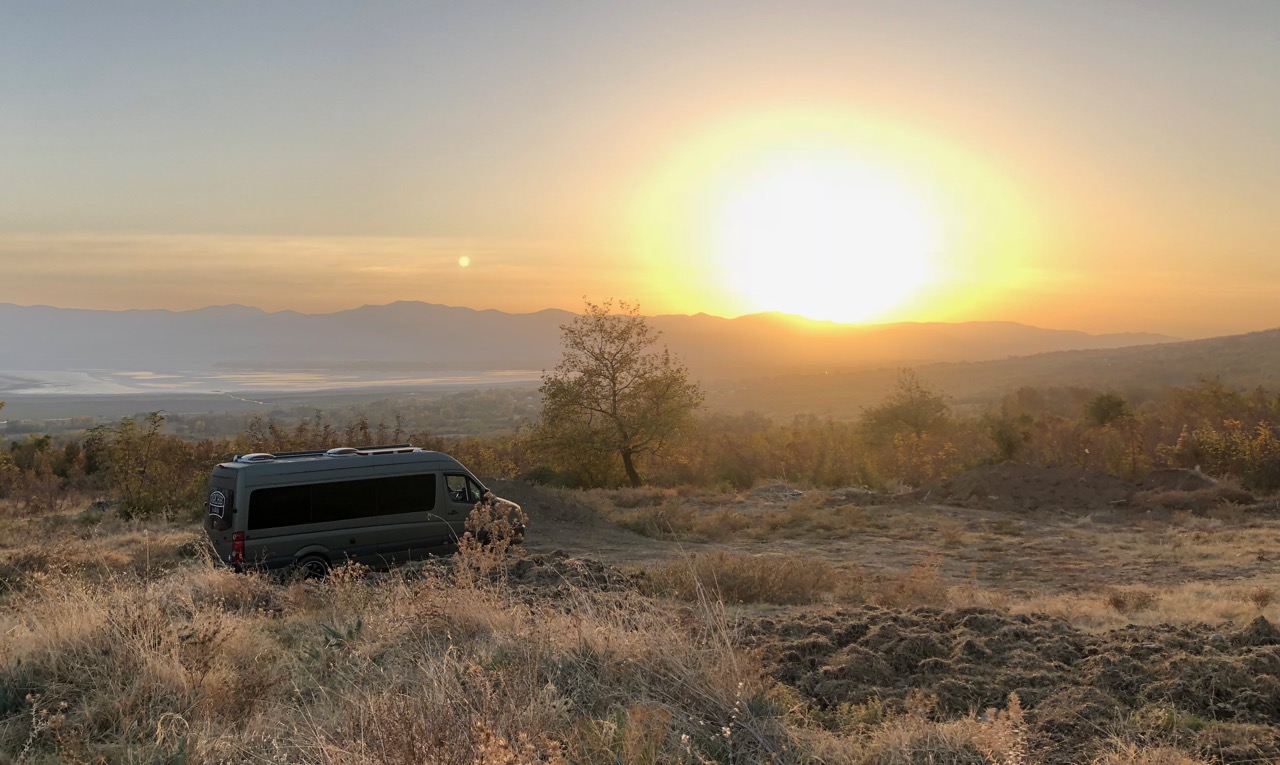
Arriving in Greece.
The approach to my crossing point near Llinden Eksohi was a dramatic reminder that we must spend time in Bulgaria next year. The last miles through the Buinovo Gorge need to be taken slowly, and with a full tank of human energy.
I mentioned how crossing into Greece brought sufficient familiarity to leave me feeling more comfortable. After several weeks of the unknown, tackled without Minty, I was glad for that rest.
At Kerkinis where spring melt waters will restore the lake again by May, the smells and sounds along with the warmth of the people were an intensified version of what I’ve loved from those previous drop ins to Greece. They don’t suffer the hordes of tourists here, and they’re interested by the foreigners who pass through.
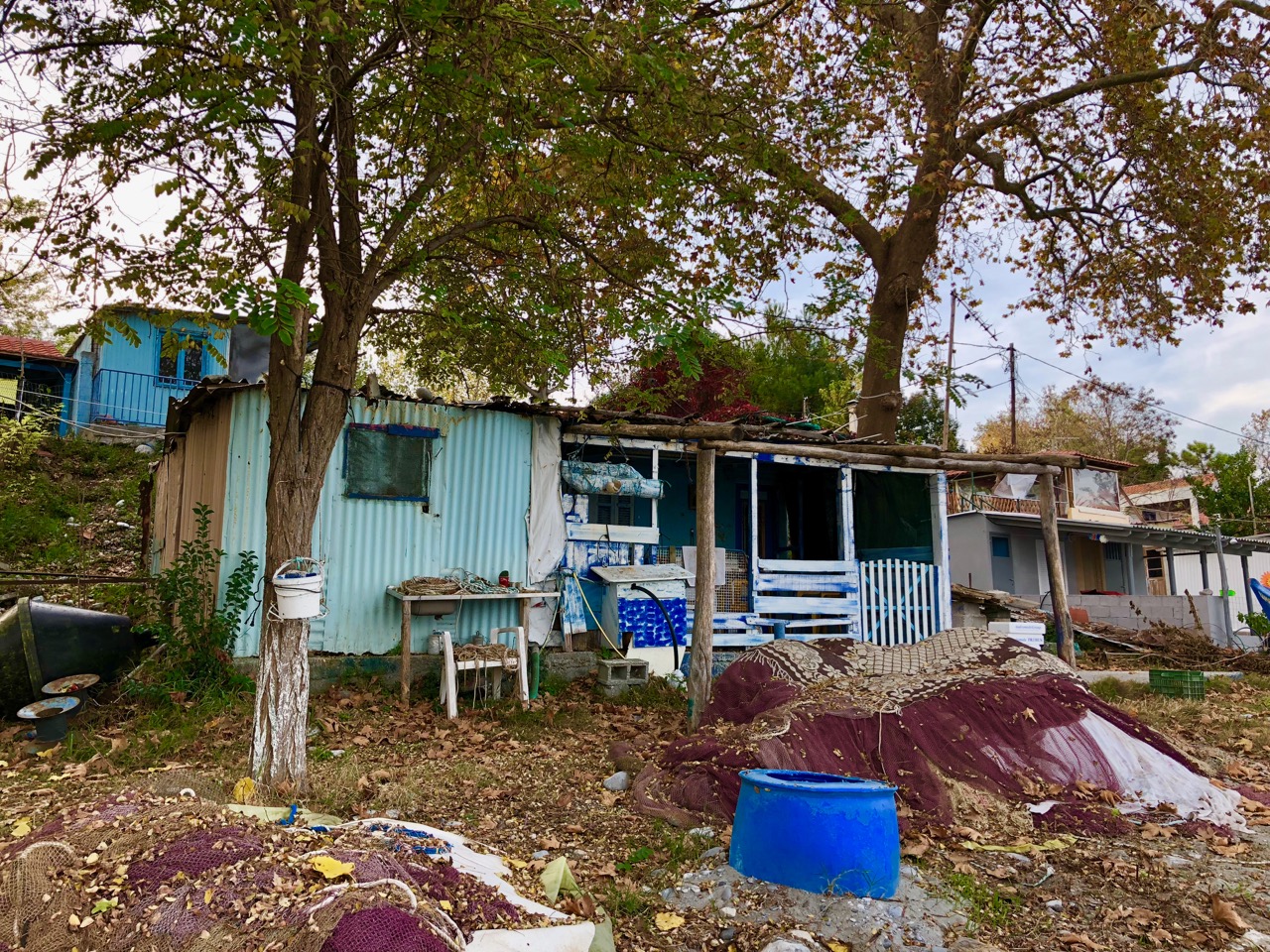
Hills. Real hills. And lots of them.
We’ve had our share of flat lands, with few real hills between the far north of Finland and the Polish Slovakian border. Now we’ll have our share of big ones.
Greece is the most mountainous country in Europe.
Polly and I had a night deeper into the wild on one of these mountains with views like we haven’t seen in a very long time – and we thought that was a slice of heaven. It has got even better since.
In Thessoloniki for practical convenience we stopped over at Zampetas Caravan and Motorhome Centre, it’s noisy, dusty, far from romantic, but an excellent facility that was ideally placed for collecting Minty from the airport, fuelling up, and a supermarket run. Thanks for the suggestion Mike!
We plotted a route to get us to Lefkada in five days. Nothing too strict. Open to change. We then meandered along it in a fairly random fashion, being drawn off course by whatever took our fancy, returning to the route once satisfied. And oh what meanders they were!
A detour to see the Royal Tombs and theatres at Aigai, now Vergina ended up more of a social affair than a lesson in ancient history. We arrived on Friday afternoon to learn that many sites close at 2pm, including here, and don’t open at weekends.
What we missed in archaeology we gained in meeting Paul and Julie, a couple from Devon, who’ve been on the road a similar time to us. We bantered for a few hours over coffees while the café owner plied us with her mum’s quince preserves, and a huge bag of kiwis. A good reminder of what a great bunch the people on the road tend to be.
We were all keen on seeing Mount Olympus and communing with the gods. There’s a road up and so it should be easy… so we thought.
Limani Litochorou.
Although the distance to the most famous Greek mountain wasn’t great, the time was long so we headed for the coast nearby and our first Greek beach.
On Sunday morning we woke with the sun bouncing off the Aegean Sea at one window, and Mount Olympus at the other.
We’d both built Greece up in our minds, yet thankfully it was delivering even more than we expected.
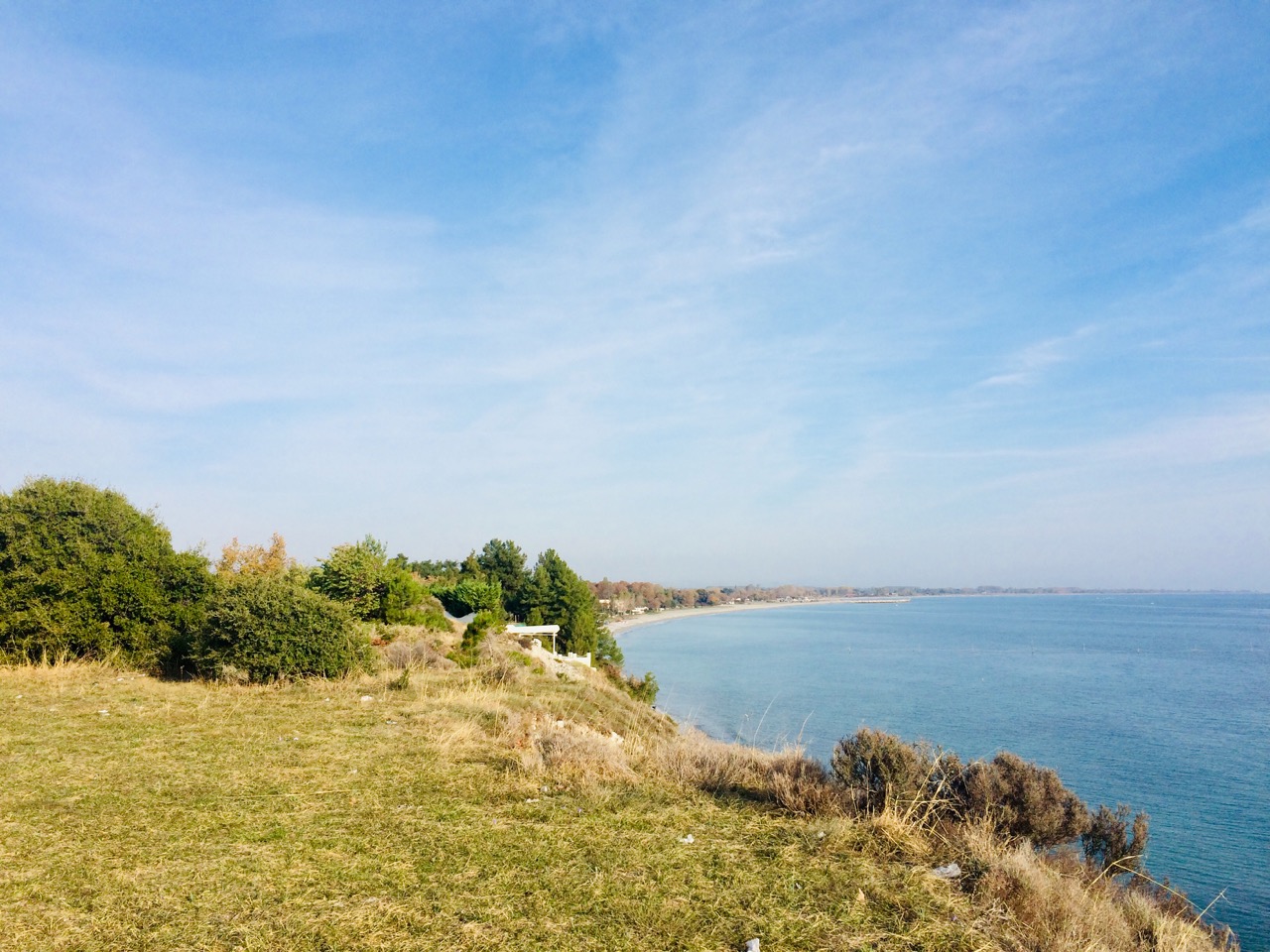
Olympus’s Revenge.
Setting off on Sunday morning from Limani the navigation was suggesting a very low average speed for getting to Mount Olympus. Well, that’s OK, we have the time. We were on the wrong side of the mountain, so the road took us on the most beautiful tour of the surrounding countryside, generally climbing, always in low gears, frequently gasping in wonder at a very different autumnal scene than those of the forests further north. These hills are so steep, yet still little villages cling to the sides.
We stop for coffee.
Old men sit outside the cafe, playing cards, rerunning the same story, harking back to times now so long past. It’s Sunday and many are in suits. They want to shake my hand. I’m delighted.
The coffee here is €1 a shot – at Vergina it was a shocking €5. Let’s live here Minty.
Onwards up the hill.
In a little village at the foot of Olympus we squeeze through our first tight spot that wouldn’t have been possible in a wider van – I’m sure there’ll be more.
And we start to climb.
At first it’s steep, but that’s the only challenge.
Then come the switchbacks, with plenty of loose surface grit to make it harder to retain traction. After a few miles of serious climbing I notice, but choose not to mention, that the navigation is suggesting it’s a 10 mile climb, but ten miles that’ll take an hour and twenty minutes! Not walking. Driving! Holy moly it must be hard.
A transit van passes on its way down. That’s comforting, everything else we’ve seen has been 4×4.
Then the finished road stopped.
That’s common here, in fact in many countries. It’s just a bit alarming for us Brits used to driving on tarmac all the time.
The gradient increases and I’m thankful that it’s dry, that it has been dry for months.
The ruts are getting deeper.
ArchieVan’s motorway tyres are slipping a bit more that I’d like.
The drops off the edge are extreme.
I can sense Minty’s nervousness, but I couldn’t see that her nails were dug deep enough into her palms to draw blood.
It’s not good to induce that much adrenalin on her third day back – and it doesn’t do a lot for your calm as a driver. As I realise that my excitement is now edged with fear I begin to question the wisdom of taking quite such a large van over such serious terrain.
And I start to look for an opportunity to turn.
What fun that was.
I knew the lean would be considerable so I asked Minty to hop out to guide me around. Not because I needed guiding, but so she wouldn’t need to feel the angle the van would be at while turning.
But hey – I’m here typing this, so clearly we made it!
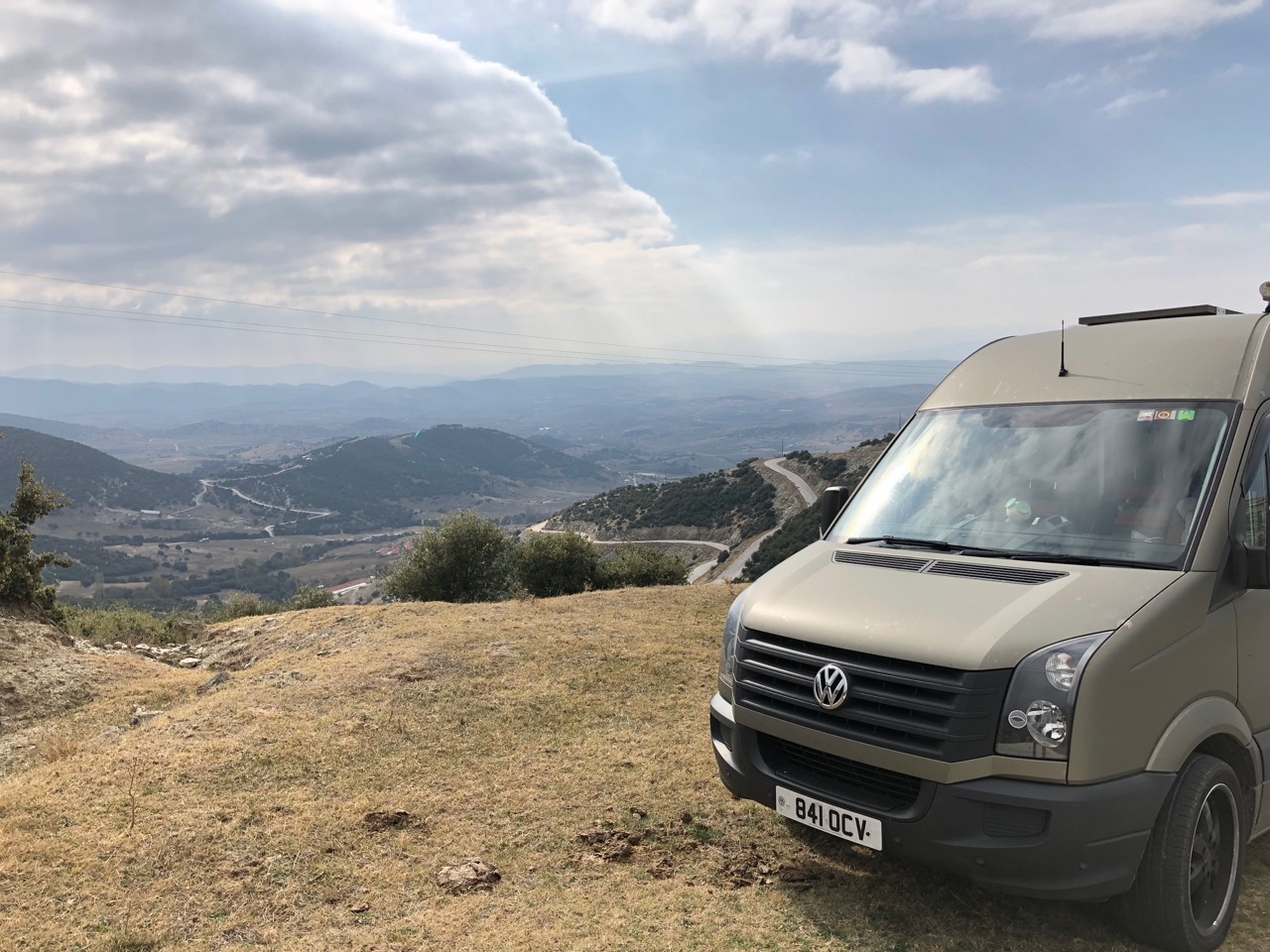
Vlachava.
We didn’t feel that we’d missed out not getting higher on Olympus, perhaps we’ll walk it one day.
Our evening stop over point at Vlachava in the Pindos mountains offered just as much beauty, possibly more as there was so much to feast our eyes upon.
In the evening when we pulled up the valley was hazy.
We were hazy too after visiting the Eagles Nest Taverna and trying a couple of their tsipouro, a locally made ouzo that truly blows the cobwebs away.
The log fire was ticking over nicely and there was a definite chill in the air. We’re high up and winter will strike here soon.
We shared the view that night with a French couple in a cool old motorhome and they pointed out the monasteries on the hilltops below us in the morning.

Meteora.
I was curious to notice a raised beach here, nearly a thousand metres up. The sandstone of much of the area supports the potential of this once being seabed, thrust upwards many millions of years ago.
And it’s on top of columns of sandstone that the monasteries of Metoera are built.
For days now we have gasped so many wows…
At a narrow view of the sparkling sea glimpsed through a gap in the mountains.
At the hills layered over each other as far as the eye can see.
At beautiful villages clinging to hillsides, old men gracing every café.
At ancient ruins, right on the roadside with a simple sign, usually only in Greek, to tell you what once stood there.
But there is nothing that can prepare you for the spectacular sight of these six monasteries, and ruins of others no longer maintained, that you approach descending from Vlachava.
They look like buildings from a fantasy world created in CGI, and getting to them was once as difficult as a fantasy film might suggest.
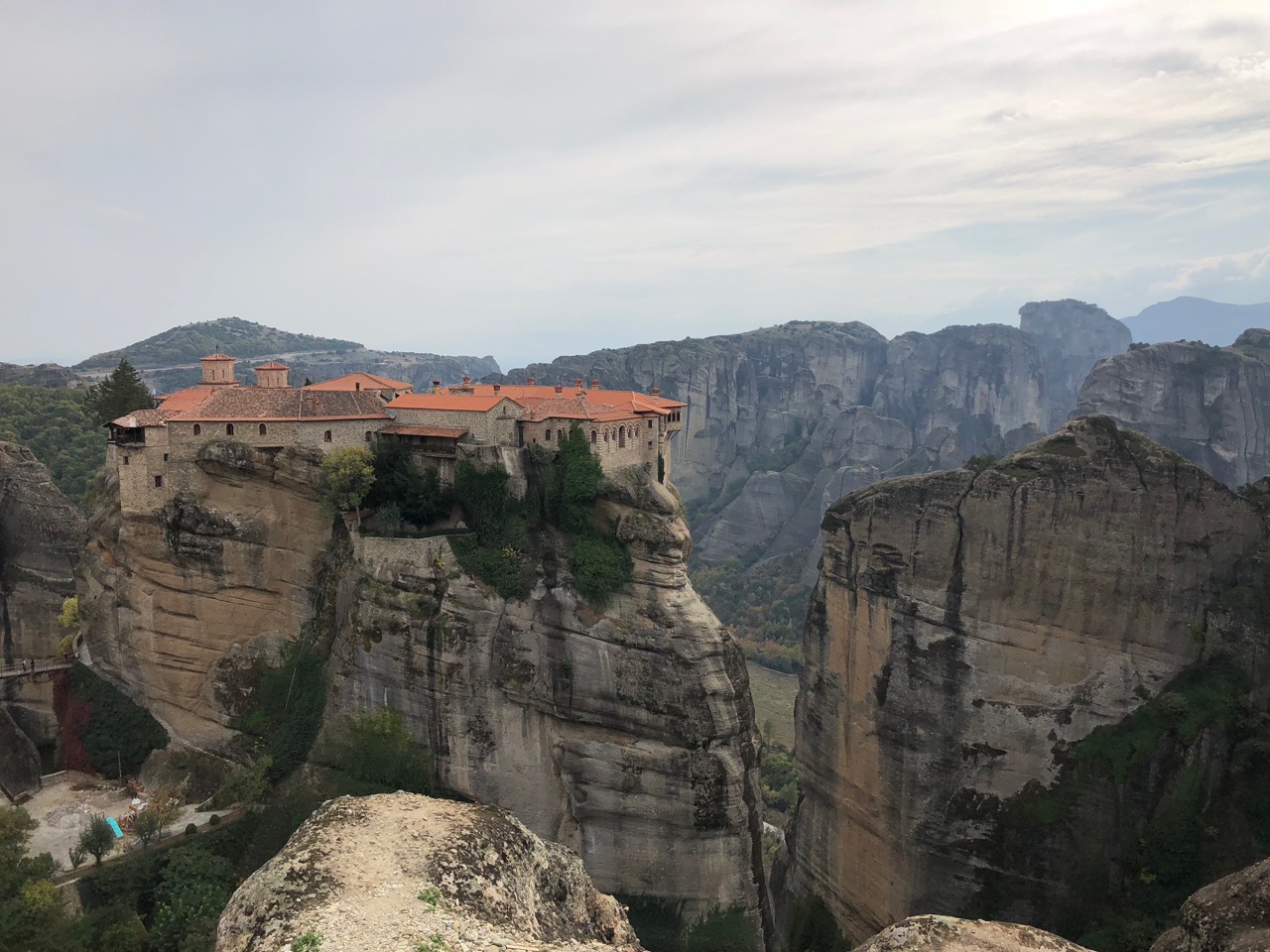
Hermit monks seeking an escape from the invading Turkish forces at the end of the 14thcentury apparently colonised the rocks, many living in caves, eventually building 20 monasteries there. Access was by a series of ropes and ladders, and utterly precarious. It’s only in the last hundred years that steps have been cut into the rock, and bridges built.
The detour to get to Meteora from the main E90 motorway across the island is about an hour and a half, and utterly worth doing if you get the chance.
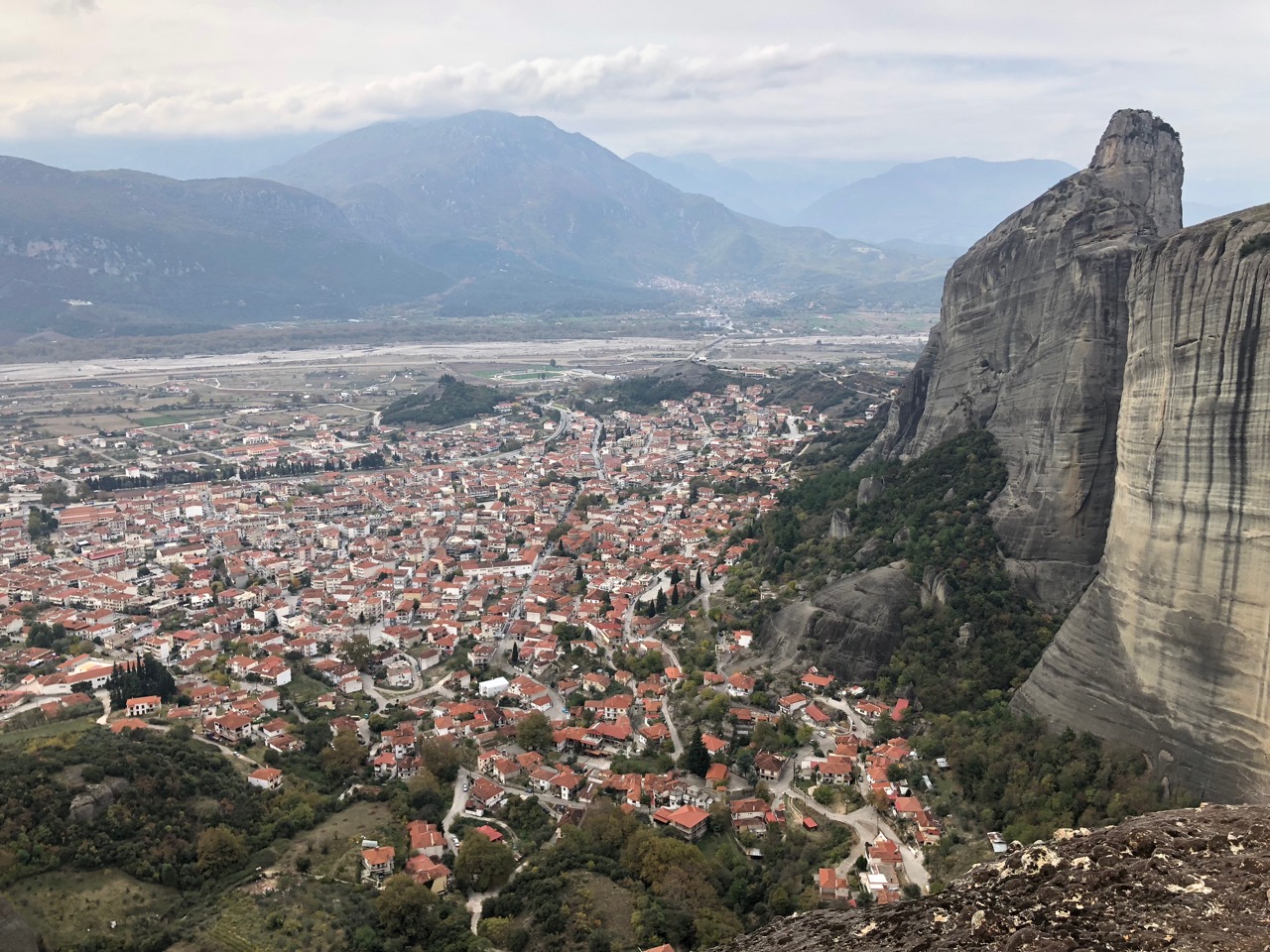
Ioannina
Ioannina, the principal town of the Epirus region sits on the rather beautiful Lake Pamvotida. The town doesn’t feel in the best of health and certainly doesn’t match its online description of wealthy and aristocratic.
The lake and surrounding mountains take on a purple hue at dusk, and the water steamed atmospherically at dawn. From our little campsite on the lakeside all seemed well.
It was on our stroll around it felt more foreign than most of Greece so far. A big gang of lads looking like they were up to no good, burnt out buildings, the usual communal bins overflowing and the castle heavily graffitied and littered.
The old streets lined with individual small shops helped restore a good feeling. It’s a university town and the student population ensures that there are plenty of bars open year round.
It’s worth longer than we gave it. It’s not far away and we may well make it back there.
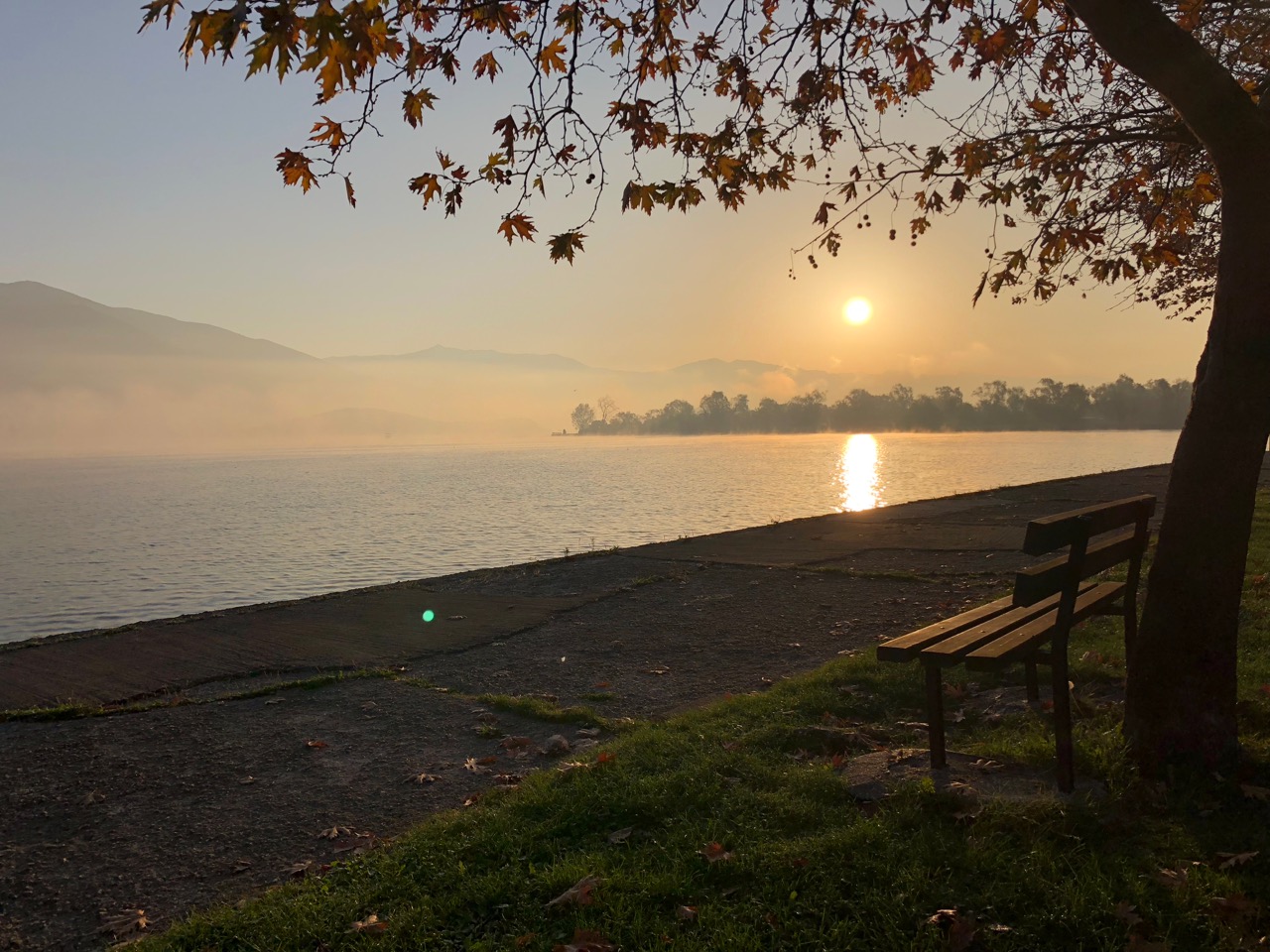
Vikos Gorge. Zagori.
This was to be our most northerly adventure before heading down to Lefkada. It was recommended by one of our guests at ArchavonStudio before we left.
Not far from Ioannina, on the road to Albania, we swung off to the right and started climbing steadily.
The drama of these mountains is intense. They eschew the foothill for instant height.
For now the dizzying drop was on the other side.
There are not many villages in the Zagori, and those that there are look so different from anything you might consider typical. The limestone that makes the cliffs and mountains is used to build the walls, streets and roofs of the villages too.
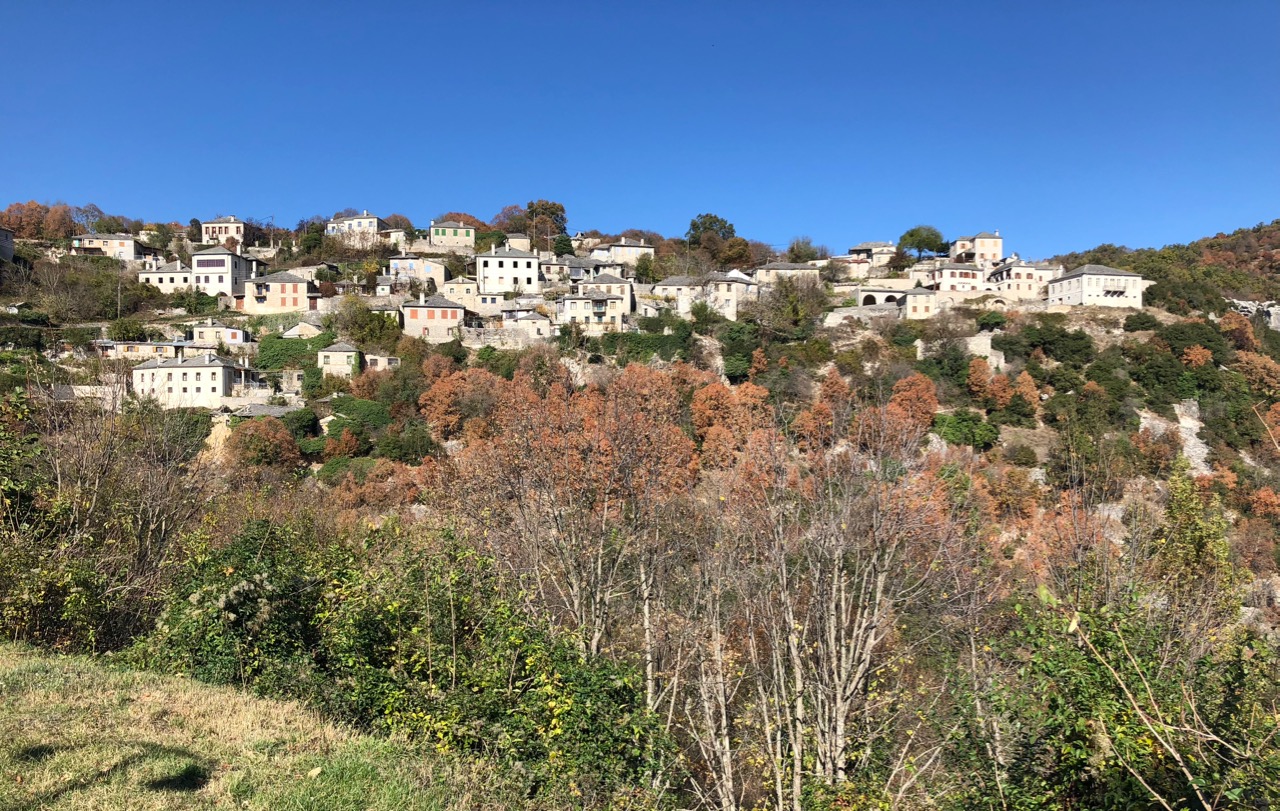
We parked at Monodendri and ambled the winding 10 minute stroll down to the Paraskevi monastery as the gorge gradually revealed itself to us.
Depending on how you choose to measure it this is the world’s deepest gorge. The Guinness Book of Records decided on this by comparing its width against its depth – at its narrowest it’s only 3 metres wide, but plunges a thousand metres deep.
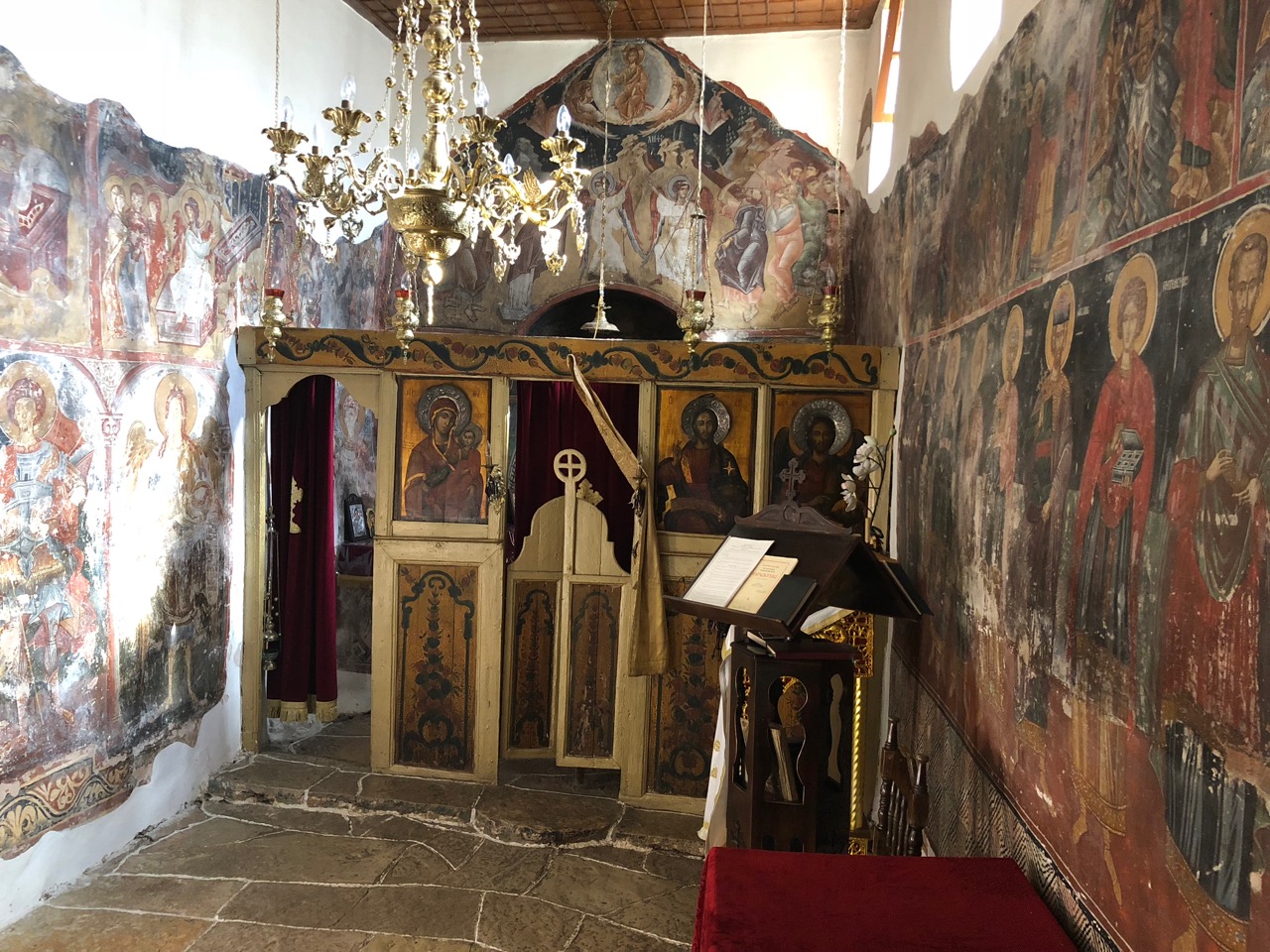
From the monastery the view mines the depths of your most impressed wows, and the monastery itself deserves time. Its frescoes and precipitious location still stir the soul and must have made a deep impression on the more religious folk of the past.
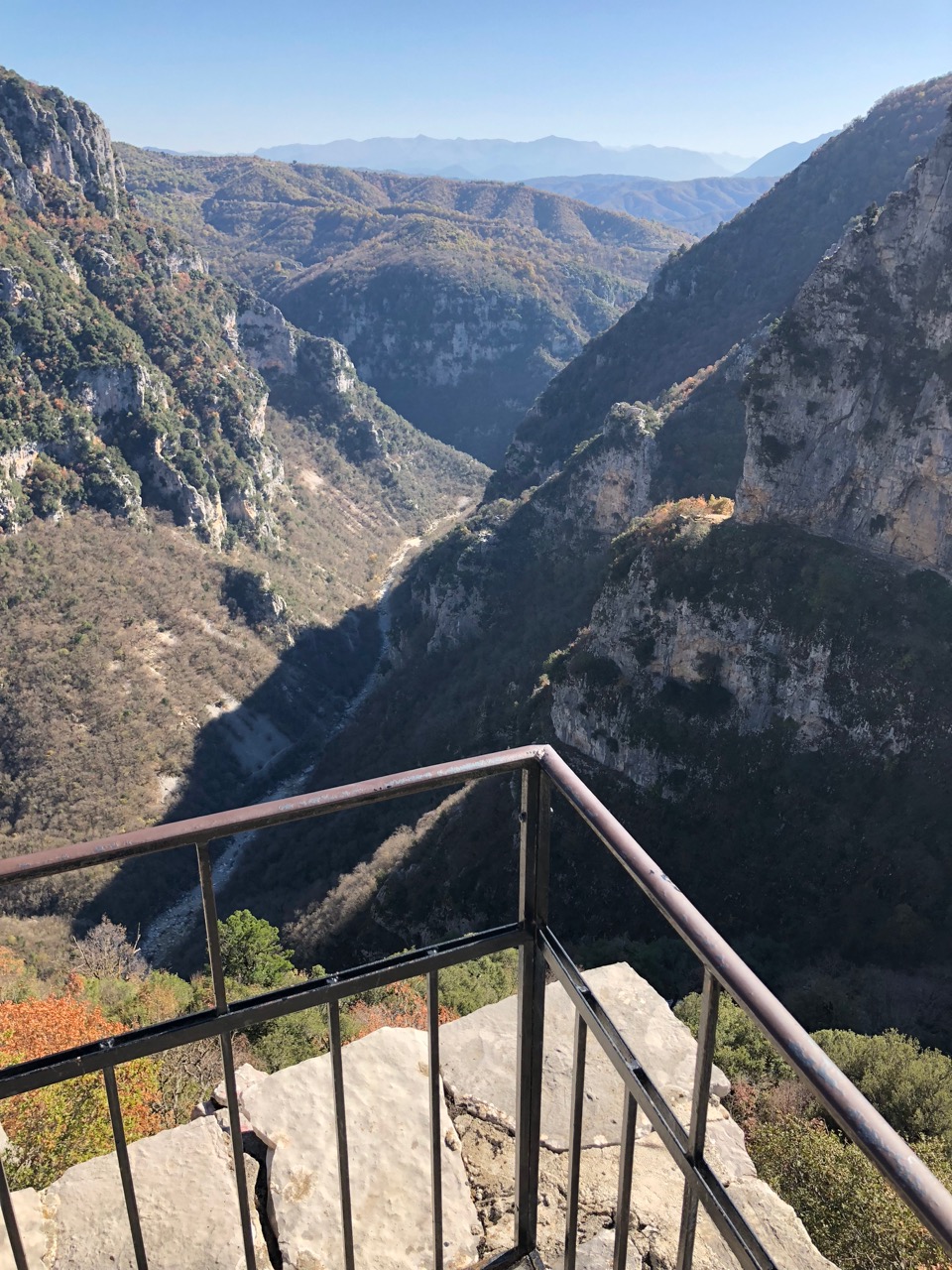
This was a quick visit. We must return and walk the gorge, taking in some of the other villages too.
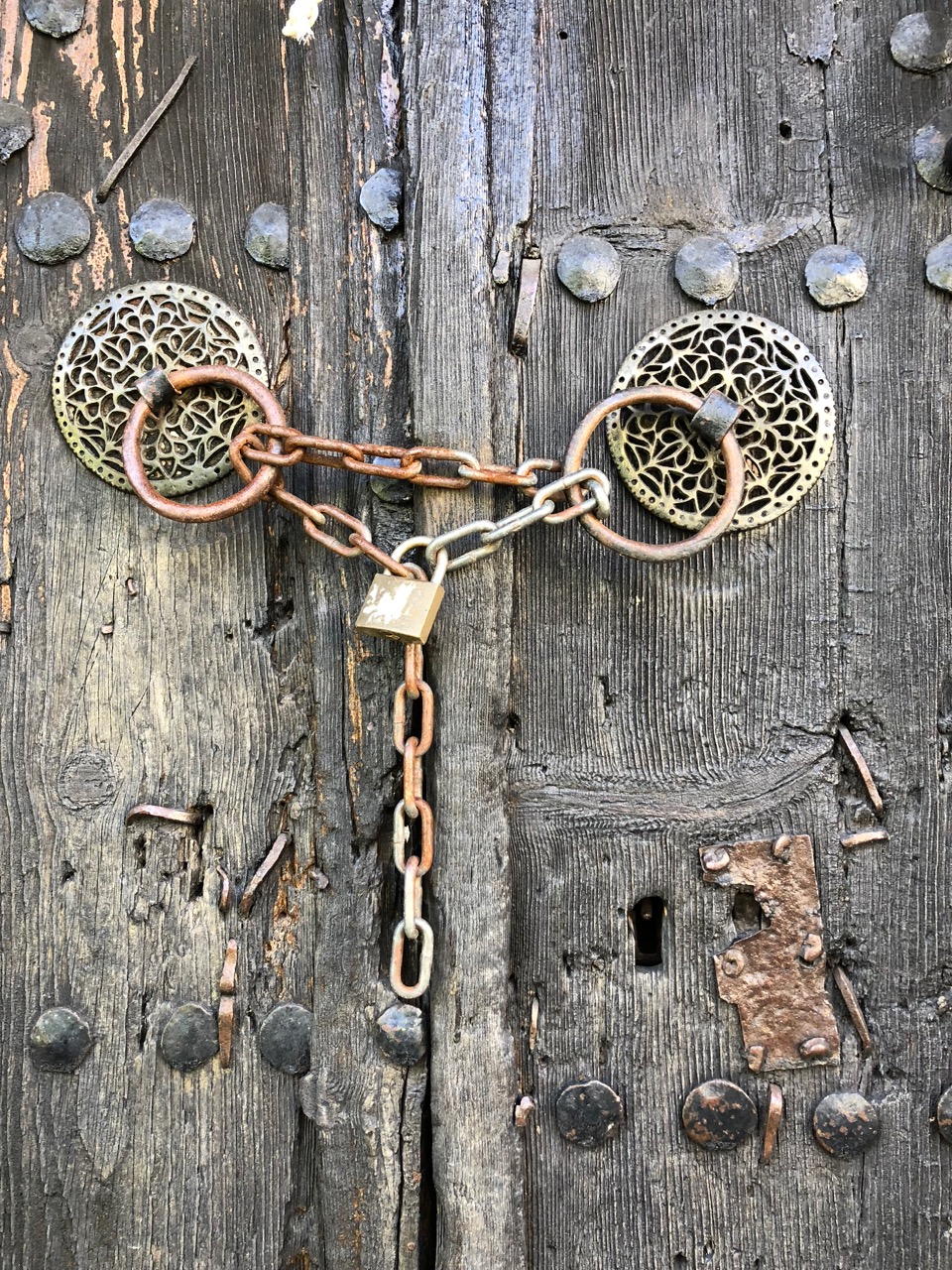
Plataria.
One last stop before our winter home.
We were hoping to get to Parga, but after a few hours driving in the mountains I’d had enough. That was OK though. This little stop over was ideal.
Plataria is a little fishing port on the west coast where nearly everything was closed for winter, just a bar for the old men, and Dreams, a bar for the younger folk. We headed to the latter and were treated to delicious bruschetta with our beers as we watched the boats come in and the sun go down. Marvellous!
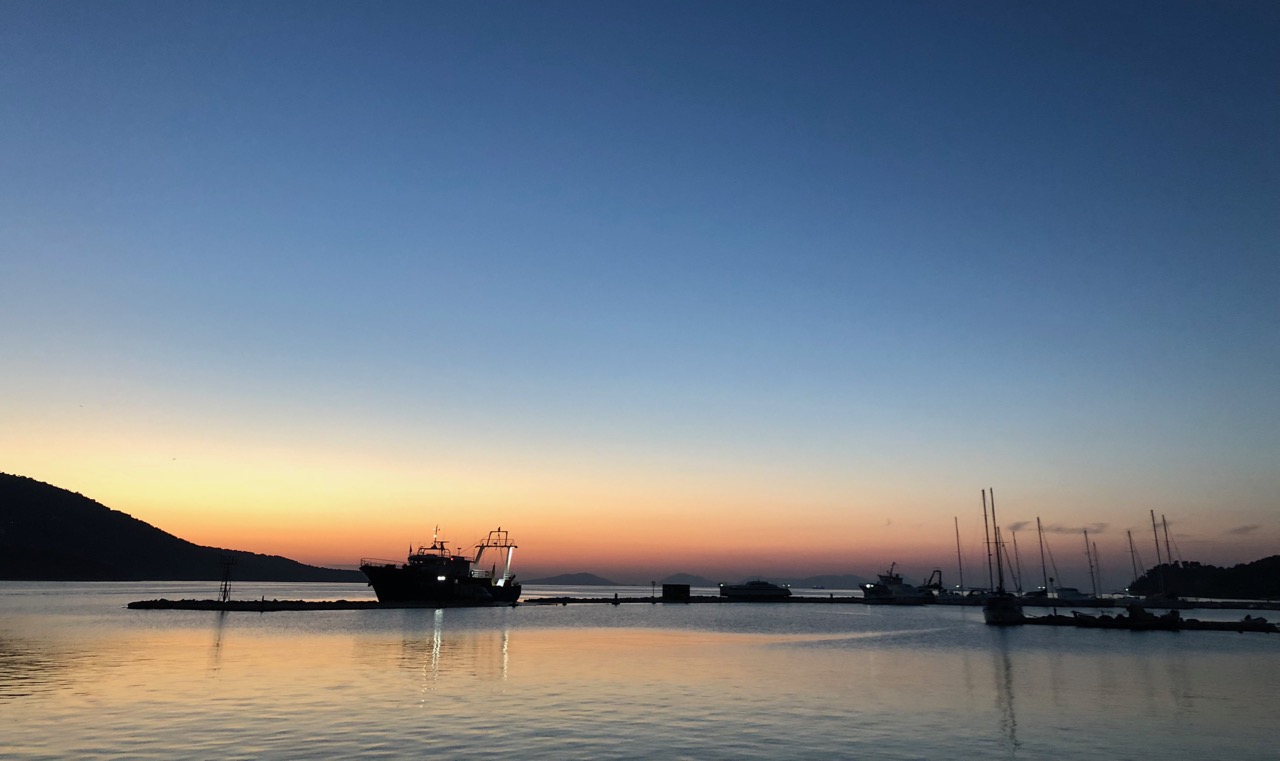
On to Lefkada.
Only a couple of hours driving left.
I fill up with fuel. I wish I’d done so in Bulgaria, it was so much cheaper there, and was surprised to get a hard sell of the owner’s olive oil. Had it come in anything smaller than 5 litre flagons I may have had some. He looked at me as if I was a fool (perhaps he was right) for asking if he had any one litre bottles.
ArchieVan shakes over the seriously rattly metal swing bridge and we’re on Lefkada.
The Corinthians cut the 3.5 mile Lefkas Canal effectively creating an island of what is really a large peninsula. They wouldn’t have believed that increased EU funding for island communities might be possible in hundreds of years to come. But then they wouldn’t have believed European union could be possible either.
Sivota. Lefkada.
We hope to be here for some time so for now I’ll just say we arrived at Villa Noe, met Roza, the house’s lovely Dutch owner, and sat back in awe of our surroundings.
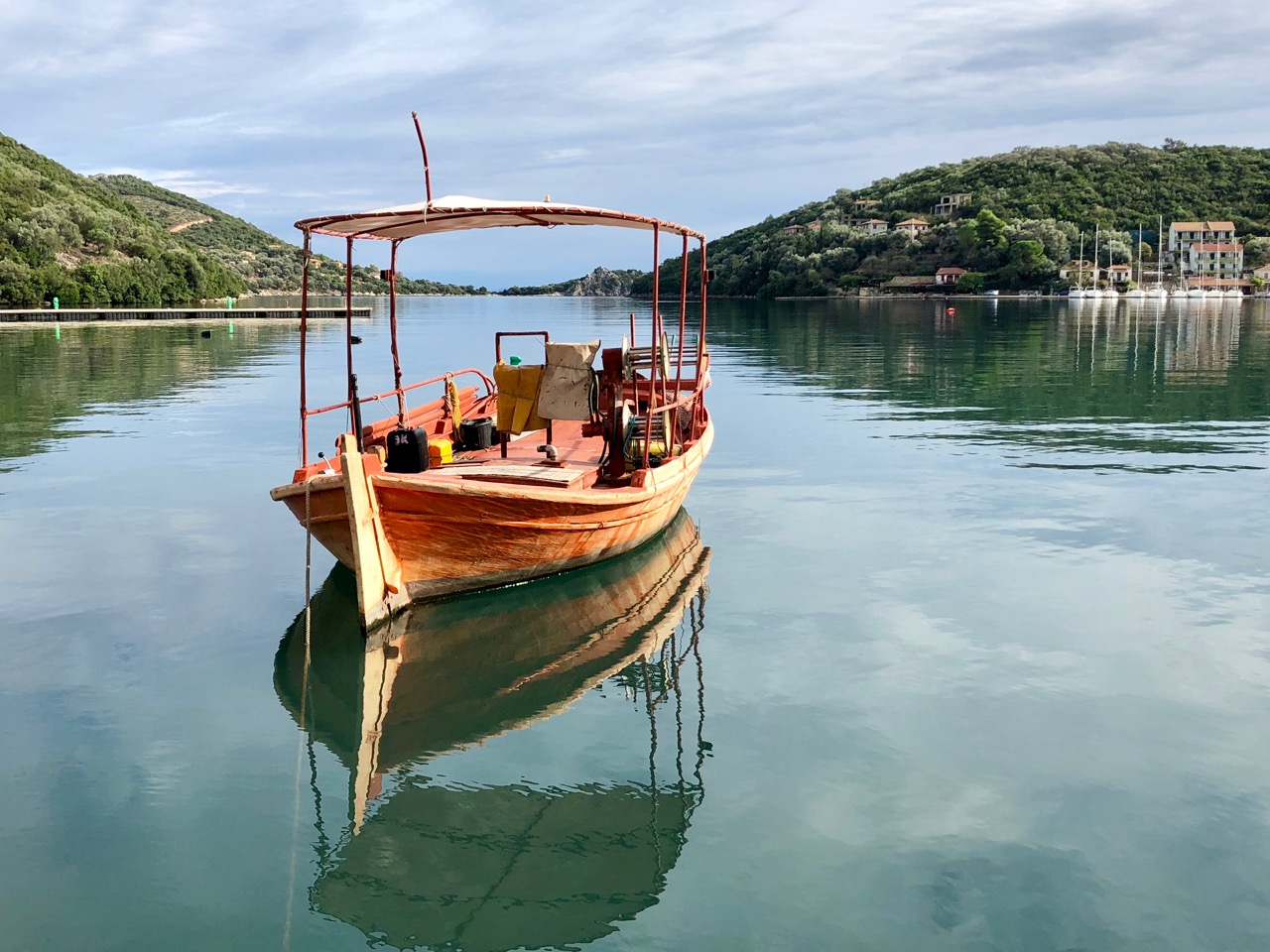
Greece go clean yourself.
This is depressing.
This beautiful country is disappearing under rubbish.
Yes, I know the state is knackered and the public services we take for granted simply aren’t available here.
But that doesn’t excuse the littering that spoils most beauty spots.
I don’t remember it like this.
So what’s to be done? Well for a start, just go pick up the rubbish. As Cornwall’s beaches have beach cleans surely so can Greece’s. We’ve committed to cleaning up our little beach down the road. Perhaps no one will notice. But we will.
Fuel prices.
Fuel prices vary wildly across Europe, and here is the most expensive we have seen, although Italy is reported to be worse. I’ve seen unleaded at €1.85 a litre here, whereas up the road in Bulgaria it was more like €1.15 – that’s an astonishing €50 difference on a tank! Admittedly that was an extreme example, we’re paying around €1.40 a litre on diesel, but that’s still over €20 more than the cheapest we’ve bought.
More from the 6 Month Report.
I’ve answered many individual questions from the 6 Month Report, some are worth sharing too. I’ll spread them over the next few posts.
Adapters.
As you’d expect, Britain does things differently. In many ways.
A few things you need to know about in a van include adapters for electricity and gas.
Most places that offer electric hook up will have a few terminals with a UK compatible socket, but if you take an adapter you’ll not get stuck, and you’ll have a lot more options open to you.
Of course you’ll also need your standard household adapters whenever you charge up your small appliances in a café, hotel or wherever.
LPG is widely available across Europe, although only in a few places in the Scandinavian countries. As you travel south many more cars run on LPG and as with petrol and diesel it’s super cheap in Bulgaria. In Western Europe garages tend to carry all the brass adapters needed for different fittings, but once you get south of Poland the onus transfers to the driver. That makes complete sense, but it did catch us out. When Amanda came back from the UK she brought a set of adapters with her, they cost about £30.



it looks as though you are going to have quite an adventure in Greece, is the name of the property (Sivota) in the picture the villa you are renting?
Have fun.
Cheers
Rick
Hi Rick. I feel I could happily wander this country for years and still find more.
I haven’t taken any decent pictures of the house yet – but there’ll be plenty to come.
KC
Kelvin good to hear you sounding happier now you have Minty back and Polly seems to be on the mend.
The dog will be on three legs for months yet, what a shame she’ll miss the amazing walking here in Greece, but she has to be strong for the vets to have another go at rebuilding her.
I have a feeling this will become A&KC’s playground …a land where you can roam at will, relax, appreciate, write, be. Make the very most of it ?✨?
I would be delighted to spend a couple of years in Greece, I reckon I’d head inland, ideally in the Zagori mountains we visited briefly last week.